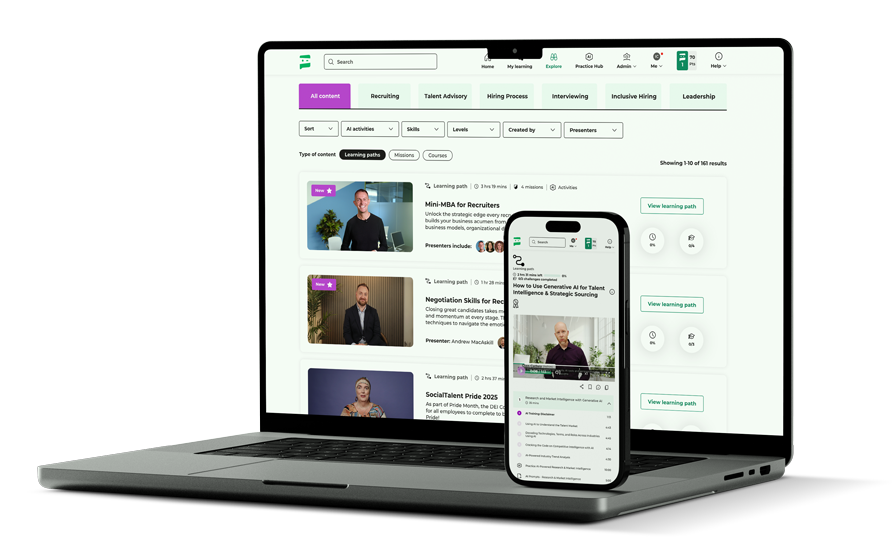Career Conversations Matter Now More Than Ever for Internal Mobility, with Dr. Bev Kaye
What you’ll learn in this playbook?
1. Introduction
2. Career Conversations: How to Make Them Meaningful
3. Developing Your Team’s Mobility Mindset
4. Conclusion: Talk is Cheap – But Career Conversations are Priceless
Introduction
Let’s be real – employees are sticking around. But are they truly growing, or are they simply taking up space like office furniture?
Talent is more mobile than ever. The competition for skilled workers rages on, but employee retention is just the beginning. The traditional view of career growth, where employees are expected to stay put and be grateful, is no longer effective. The reality? Talent doesn’t just want a paycheck anymore; they want purpose, growth, and opportunities for development and internal mobility that align with their personal and professional goals.
After massive layoffs, restructuring, and the ongoing uncertainty of a post-pandemic world, those who remain often get overlooked. But here’s the catch – just because employees stay doesn’t mean they’re thriving. Stagnation leads to disengagement, and when employees feel stuck, you risk everything from quiet quitting to full-blown turnover. Your talent, once loyal, might start straying.
That’s why career conversations matter now more than ever. The global talent market is evolving, and employees are increasingly seeking workplaces that prioritize growth, development, and internal mobility. They need to see a future within your organization, not just beyond it. They need to feel valued, challenged, and supported in their journey. Leaders today must do more than manage tasks – they need to nurture talent and provide clear paths for growth in an ever-changing environment.
And here’s the kicker: Career development doesn’t have to be complicated. No massive budgets. No corporate red tape. Just five simple actions that transform everyday moments into powerful growth opportunities. It’s the conversation with managers that counts.
Learn more: What is Internal Mobility?
Holding Career Conversations with Your Direct Reports
The world of work is evolving at breakneck speed – emerging economies, disruptive technology, shifting business strategies – everything is in flux. To navigate these changes, companies need agile, resilient employees who are continuously growing and developing to fuel internal mobility.
As a leader, your role isn’t just about managing tasks; it’s about motivating, inspiring, and helping employees thrive. The good news? You don’t need all the answers. What you do need are great questions – because employees don’t want a one-sided lecture, they want a real conversation.
Career Conversations: What Employees Really Need
- A safe space to explore their options
- A guide, not an expert, to help them think through possibilities
- Actionable steps they can take to grow – right where they are
What I Assume About You (And Why It Matters)
✔ You believe developing talent is important – you know growth matters.
✔ You’re busy – you don’t have endless time for career discussions.
✔ Your organization is going through change – and your team’s success is tied to how well they adapt.
✔ Your team’s growth directly impacts your success – when they develop, everyone benefits.
The Development Mindset: Five Actions for Supporting Employee Growth
Helping employees develop their careers and advocating for internal mobility doesn’t always require grand programs or endless meetings – it starts with five simple actions wrapped in meaningful conversations.
The Five Key Actions
- Know Their Talents – Understand what your people do best.
- Offer Your Perspective – Share insights about their strengths and potential.
- Discuss Career Trends – Talk about industry changes that could impact them.
- Explore Multiple Options – Help them consider more than just one path.
- Collaborate on Action Plans – Work together to define next steps.
Why These Conversations Matter
Employees stay engaged when they know their manager and organization truly care about their growth and mobility. Lack of career visibility is one of the top reasons people leave. When employees don’t see their future in your future, they look elsewhere.
Learn more: 5 Benefits of Internal Mobility for Employers
Step 1: Know Their Talents
The first step in any career conversation is understanding your employees’ unique strengths, values, and interests. This isn’t always easy – some people hesitate to talk about their talents, fearing they’ll sound like they’re bragging. Others struggle to put their skills into words.
Your job? Get curious.
When you ask thoughtful, open-ended questions, you uncover hidden strengths, untapped potential, and motivators that drive engagement. But asking is only half the battle – the real challenge is to listen.
Great listening isn’t passive – it’s active, engaging, and exploratory. Treat it like a research project: ask, listen, then dig deeper. The better you understand your team’s talents, the more effectively you can match them to opportunities.
Five Questions to Uncover Talent & Motivation
- What does career success look like to you? (Everyone defines it differently.)
- What makes you unique? (In this team, this department, this organization?)
- Tell me about an accomplishment you’re really proud of. (Be as specific as possible.)
- What makes for a really good day at work? (Listen closely—this reveals values and interests.)
- What lessons have you learned from success or failure? (Growth often comes from both.)
Step 2: Offer Your Perspective
If there’s one word that strikes fear in business, it’s feedback.
But when it comes to career conversations, offering your perspective isn’t about criticism – it’s about clarity. Employees need to understand how they’re perceived, what they’re known for, and how they can actively shape their reputation.
The Power of Perception
Today’s workplace is more networked, dispersed, and interconnected than ever. Employees don’t just work for a manager; they work in teams, across departments, and with external stakeholders.
Decisions about promotions, new opportunities, and internal mobility aren’t made in isolation – they involve multiple voices.Your role isn’t just to provide feedback, but to help employees gather insights from others and reflect on how they’re seen in the organization.
Key Questions to Spark Self-Reflection
- What is the most helpful feedback you’ve ever received? How did it change your behavior? How did you apply it?
- If you asked three colleagues to name your greatest strength, what would they say? Who would you ask?
- In which areas do you wish I would give you more feedback? How can I help you feel more successful at work?
- Which of your team skills are most valued by your colleagues? How do you know?
- Based on feedback from others, which skills do you hope to improve?
Step 3: Discuss Trends
Organizations must be future-focused and strategic to stay competitive – and so must employees. Career success isn’t just about what’s happening today; it’s about anticipating what’s next.
Helping your employees understand industry shifts, emerging skills, and market changes will prepare them to adapt, grow, and seize opportunities in a rapidly evolving workplace.
Why Trend Awareness Matters
Think about major disruptions – like the pandemic – which forced rapid reinvention in how we work. Employees who could adapt quickly thrived, while others struggled. By discussing trends openly, you help your team see change as an opportunity, not a threat.
Encourage employees to look beyond their current roles and identify the forces shaping their future.
Five Key Questions to Explore Trends
- Which major economic, political, or social changes will have the greatest impact on our organization, division, or function?
- What is the single most important growth area our company must focus on in the coming years?
- How will our profession evolve over the next three years? What strategies should we use to prepare?
- What marketplace trends will impact our business? How will our customers’ needs shift as a result?
- What internal business changes will significantly impact how we work in the next year?
Making Trend Discussions Actionable
This conversation isn’t about having all the answers – it’s about asking the right questions and encouraging collaborative exploration.
- Bring team members together to debate and share insights.
- Discuss implications for individual careers and the team as a whole.
- Encourage employees to track industry trends and emerging skills.
Step 4: Explore Multiple Options
Employees thrive when they see multiple pathways for growth – not just upward moves, but alternative career development options that align with both their aspirations and the organization’s needs.
By broadening the definition of career success and what internal mobility can look like, you help employees see opportunities within your organization, reducing the likelihood that they’ll look elsewhere for growth.
Four Alternatives to Moving Up
Enrichment – Growing in place by expanding expertise.
Lateral Moves – Moving across teams or functions for new experiences.
Exploration – Short-term gigs or projects to test new options.
Realignment – Stepping back to refocus or reposition for future growth.
Some managers fear losing top talent and hold employees back, but hoarding talent backfires. Employees who feel trapped will leave the organization entirely instead of exploring internal growth.
Why You Should Support Employee Growth
- Employees stay longer with managers who genuinely care about their careers.
- Developing talent benefits the entire organization, not just your team.
- You build a strong reputation as a leader who invests in their people – attracting more great talent.
- Helping others grow is personally fulfilling and strengthens leadership skills.
Five Career Development Questions
- What career goals are you currently considering? Which one feels most attainable?
- What skills or knowledge do you need to reach those goals?
- Which parts of your current job would you like to expand to prepare for future moves?
- Which key skill would be most transferable if you made a lateral move?
- What other organizational roles would you be most interested in exploring?
Step 5: Co-Design an Action Plan
In a world of constant change, organizations that fail to learn and adapt fall behind. Employees need to continuously grow, develop, and refine their skills to keep themselves and their companies competitive.
As a leader, your role is to create an environment that encourages learning, supports growth, and challenges employees to define success on their own terms.
Building a Practical and Flexible Plan
- Identify action steps for each career goal.
- Develop contingency plans in case one path doesn’t work out.
- Pinpoint obstacles and brainstorm ways to navigate them.
- Maximize existing strengths and resources to support progress.
- Encourage networking and mentorship to open new opportunities.
When employees have the tools, support, and connections they need, they become part of a learning-driven culture – one that not only meets the company’s goals but also prepares for future pivots and challenges.
Five Key Questions to Shape the Action Plan
- What skills do you still need to develop to achieve your goals?
- Which existing abilities can help you move forward?
- Who in your network could open an important door for you?
- What learning opportunities can I provide to help fill skill gaps?
- What on-the-job experiences could bring you closer to your career options?
Conclusion
Today, career conversations are more than just a luxury – they’re a necessity. By fostering a culture that prioritizes development, growth, and internal mobility leaders empower employees to see not only the possibilities within their current roles but also the broader opportunities that lie ahead. These conversations, rooted in trust, clarity, and genuine interest, are the key to unlocking potential, fostering mobility, and ensuring that employees remain engaged and committed to both their personal growth and the organization’s success.
But the key to lasting impact is integrating development conversations into the very fabric of your workplace culture. When these discussions become a regular part of everyday interactions – rather than a once-a-year occurrence – employees feel continually supported and valued. Leaders and managers must commit to making these conversations a consistent and meaningful practice, woven into the rhythm of team meetings, one-on-ones, and performance reviews.
Moving beyond mere retention, career conversations are about turning potential into performance, challenges into growth, and aspirations into actionable paths. In a world where change is constant, the ability to adapt, grow, and thrive is not just an individual pursuit but a collective one.
Dr. Bev Kaye
Renowned for her practical, ‘how-to’ approach, Bev has also authored a variety of books, including the best-selling “Love Em or Lose Em” which has sold over 750,000 copies and is regarded as one of the foremost texts on talent retention.



